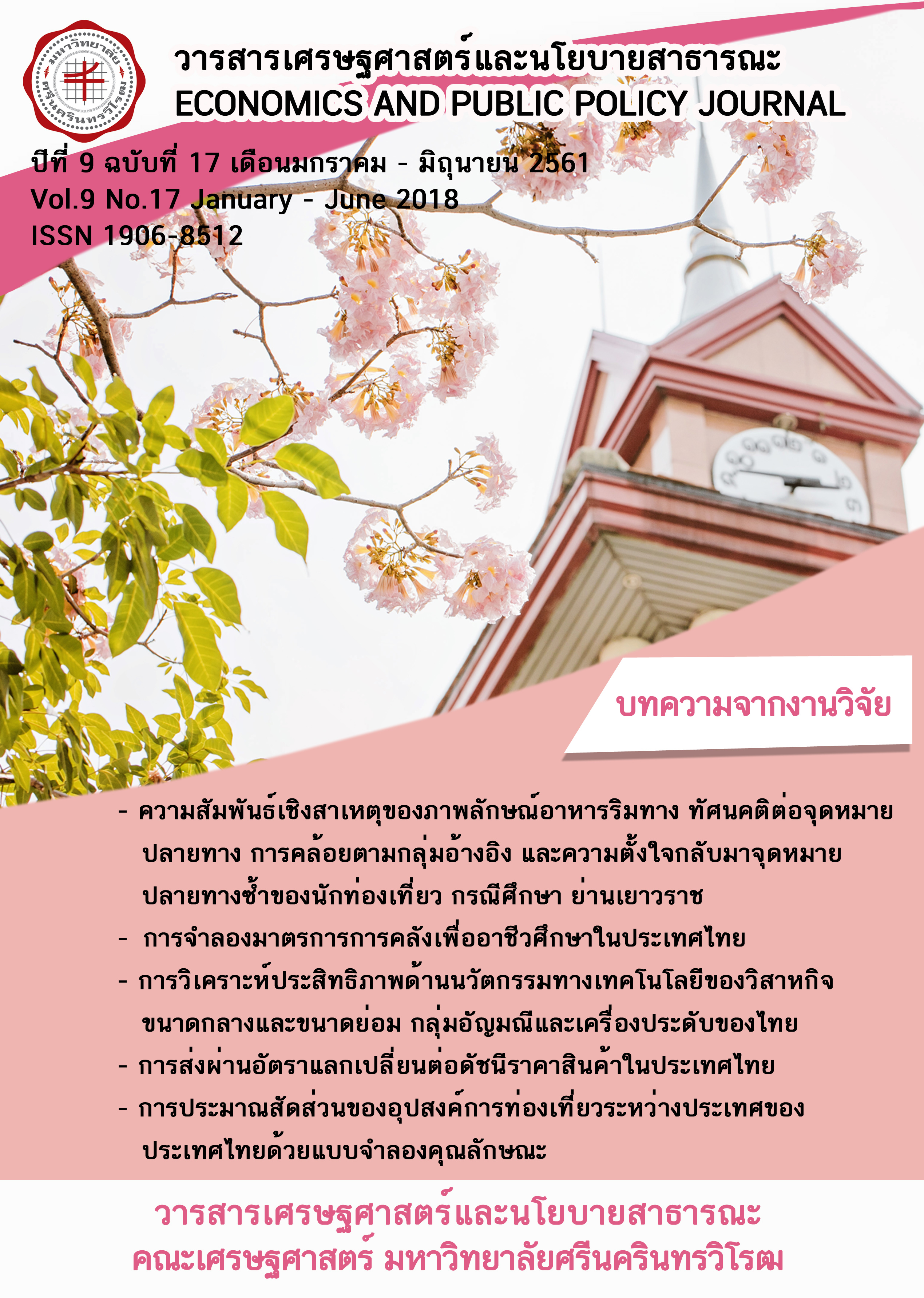การประมาณสัดส่วนของอุปสงค์การท่องเที่ยวระหว่างประเทศของประเทศไทยด้วยแบบจำลองคุณลักษณะ
Main Article Content
บทคัดย่อ
งานวิจัยนี้มีวัตถุประสงค์เพื่อ 1) พัฒนาแบบจำลองสัดส่วนของอุปสงค์การท่องเที่ยวระหว่างประเทศของประเทศไทย และ 2) ศึกษาปัจจัยที่ส่งผลต่อสัดส่วนของอุปสงค์การท่องเที่ยวของนักท่องเที่ยวชาวต่างชาติที่เดินทางเข้ามาท่องเที่ยวในจังหวัดชายฝั่งทะเลภาคตะวันออกของประเทศไทย โดยใช้แนวคิดของแบบจำลองคุณลักษณะที่ประกอบไปด้วยคุณลักษณะของแหล่งท่องเที่ยว คุณลักษณะของประเทศของนักท่องเที่ยว และคุณลักษณะที่สะท้อนปัจจัยทางเศรษฐกิจรวมถึงปัจจัยภายนอก ข้อมูลที่ใช้ในการศึกษาเชิงประจักษ์เป็นแบบพาเนลสามมิติ ครอบคลุมช่วงเวลาตั้งแต่ปี 2552 ไตรมาส 1 ถึง 2558 ไตรมาส 4 รวมทั้งสิ้น 28 ไตรมาส โดยพิจารณานักท่องเที่ยวจาก 10 ประเทศ ได้แก่ จีน ออสเตรเลีย อินเดีย ญี่ปุ่น เกาหลีใต้ มาเลเซีย รัสเซีย สิงคโปร์ สหราชอาณาจักร และสหรัฐอเมริกา ที่เดินทางมาจังหวัดชายฝั่งทะเลภาคตะวันออกของประเทศไทยทั้งหมด 4 จังหวัด ได้แก่ ชลบุรี ระยอง จันทบุรี และตราด
ผู้วิจัยได้ประยุกต์ใช้วิธี Non-linear Seemingly Unrelated Regression (NLSUR) ในการประมาณแบบจำลองที่ประกอบไปด้วยระบบสมการสัดส่วนของอุปสงค์สำหรับแต่ละจังหวัดพร้อม ๆ กัน ผลการศึกษาพบว่า คุณลักษณะที่มีผลต่อสัดส่วนของอุปสงค์การท่องเที่ยวในจังหวัดใด ๆ สำหรับนักท่องเที่ยวต่างชาติประเทศหนึ่ง ๆ ที่ระดับนัยสำคัญทางสถิติ 0.10 ได้แก่ ระยะห่างจากสนามบินสุวรรณภูมิไปยังจังหวัดท่องเที่ยว ความยาวชายฝั่งทะเลของจังหวัดท่องเที่ยว จำนวนสวนสัตว์ในจังหวัดท่องเที่ยว จำนวนประชากรที่ใช้คอมพิวเตอร์ในจังหวัดท่องเที่ยว ดัชนีราคาผู้บริโภคพื้นฐานของจังหวัดท่องเที่ยว จำนวนอาชญากรรมที่ได้รับแจ้งในจังหวัดท่องเที่ยว จำนวนผู้ใช้ไฟฟ้าในจังหวัดท่องเที่ยว จำนวนประชากรจังหวัดท่องเที่ยว ผลิตภัณฑ์มวลรวมจังหวัดที่แท้จริงของจังหวัดท่องเที่ยว จำนวนห้องพักในจังหวัดท่องเที่ยว อัตราแลกเปลี่ยนสกุลเงินท้องถิ่นเทียบกับบาท การเป็นสมาชิกของกลุ่มประเทศอาเซียนของประเทศนักท่องเที่ยว การเป็นประเทศพัฒนาแล้วของประเทศนักท่องเที่ยว อัตราราคาห้องพักเฉลี่ย ราคาดิบน้ำมันดูไบ ดัชนีผลิตภัณฑ์มวลรวมภายในประเทศทั่วโลก วิกฤตการณ์แฮมเบอร์เกอร์ และวิกฤตการณ์ทางการเมืองในประเทศไทย
Article Details
สงวนลิขสิทธิ์ © 2553 คณะเศรษฐศาสตร์ มหาวิทยาลัยศรีนครินทรวิโรฒ
คณะเศรษฐศาสตร์ มหาวิทยาลัยศรีนครินทรวิโรฒ จัดพิมพ์วารสารเศรษฐศาสตร์และนโยบายสาธารณะ เพื่อเผยแพร่บทความวิชาการทางเศรษฐศาสตร์ นโยบายสารธารณะ และสาขาอื่นๆที่เกี่ยวข้อง ทัศนะและข้อคิดเห็นใดๆ ที่ปรากฏในวารสารเป็นความคิดเห็นส่วนตัวของผู้เขียน โดยบทความที่ได้รับการตอบรับจะถือเป็นลิขสิทธิ์ของคณะเศรษฐศาสตร์ มหาวิทยาลัยศรีนครินทรวิโรฒ
บรรณาธิการ อาจารย์ ดร.พลพัธน์ โคตรจรัส
เอกสารอ้างอิง
Ashworth, G. and Goodall, B. (2013). Marketing Tourism Places. New York, NY: Routledge
Chasapopoulos, P.; Butter, F. A.G. den and Mihaylov, E. (2014). Demand for tourism in Greece: A panel data analysis using the gravity model. International Journal of Tourism Policy, 5(3), 173-191.
Chiewcharnkitjakarn, A. (2010). Principle of Tourism Marketing. Bangkok: Dhurakij Pundit University.
Chokethaworn, K. (2010). Modelling International Tourism Demand to Thailand: Spatial and Temporal Aggregation, Master Thesis. Faculty of Economics, Chiang Mai University.
Chowdhury, A. K. and Veeramani, S. (2015). Information Technology: Impacts on Environment and Sustainable Development. Pertanika Journal of Science and Technology, 23(1), 127-139.
Deluna, R. Jr. and Jeon, N. (2014). Determinants of International Tourism Demand for the Philippines: An Augmented Gravity Model Approach. Retrieved February 1, 2018, from https://mpra.ub.uni-muenchen.de/55294/
Department of Tourism (2018). Tourist Statistics 2007-2017. Retrieved March 4, 2018, from https://www.tourism.go.th/view/2/Home/EN-US#
Dilanchiev, A. (2012). Tourism Demand in Georgia: Gravity Model Analysis. 7th Silk Road International Conference “Challenges and Opportunities of Sustainable Economic Development in Eurasian Countries”. Retrieved March 8, 2018, from https://silkroad.ibsu.edu.ge/silkroad/index.php/silkroad/silkroad7th/paper/download/.../153
Eilat, Y. and Einav, L. (2004). Determinants of international tourism: a three-dimensional panel data analysis. Applied Economics, 36(12), 1315-1327.
Farrick, R. J. (2016). Why do tourists from developed countries tend to visit poor countries? Retrieved April 18, 2018, from https://www.quora.com/Why-do-tourists-from-developed-countries-tend-to-visit-poor-countries?utm_medium=organic&utm_ source=google_rich_qa&utm_campaign=google_rich_qa
Higginbottom, K. (2004). Wildlife Tourism: Impacts, Management and Planning. Altona, Vic: Common Ground Publishing Pty Ltd.
Kaosa-ard M., et al. (2012). Econometrics of Tourism (1). Chiang Mai: Public Policy Studies Institute.
Kaosa-ard M., et al. (2013). Tourism Economics. Retrieved February 1, 2018, from https://piboonrungroj.files.wordpress.com/2013/10/tourism_economics_final.pdf
Kaplan, F. and Aktas, A. (2016). The Turkey Tourism Demand: A Gravity Model. The Empirical Economics Letters. Retrieved February 1, 2018, from https://apbs.mersin.edu.tr/files/fatihkaplan/Publications_011.pdf
Khandaker, S and Islam, S. Z. (2017). International Tourism Demand and Macroeconomic Factors. International Journal of Economics and Financial Issues, 7(5), 389-393.
Kohli, Ulrich and Morey, Edward R. 1990. Oil Characteristics and the U.S. Demand for Foreign Crude by Region of Origin. Atlantic Economic Journal. 18(September), 55-67.
Lancaster, Kelvin J. 1966. A New Approach to Consumer Theory. The Journal of Political Economy, 74(April), 132-157.
Lorde, T. and Jackman, M. (2013). Evaluating the Impact of Crime on Tourism in Barbados: A Transfer Function Approach. Tourism Analysis, 18(2), 193-191.
Lorde, T., Li, G. and Airey, D. (2015). Modeling Caribbean Tourism Demand: An Augmented Gravity Approach. Journal of Travel Research. Retrieved February 8, 2018, from https://journals.sagepub.com/doi/abs/10.1177/0047287515592852
Marrocu, E. and Paci, R. (2012). Different tourists to different destinations: Evidence from spatial interaction models. Working Paper CRENoS 2012/10. Retrieved April 18, 2018, from https://www.siecon.org/online/wp-content/uploads/2012/08/Marrocu-Paci-SIE2012_Tourism-flows.pdf
Matias, Á. (2004). Gravity and the tourism trade: the case for Portugal. Retrieved from https://www.witpress.com/Secure/elibrary/papers/ST04/ST04005FU.pdf
Ministry of Tourism & Sports (2018). Tourism Plan 2018. Retrieved March 4, 2018, from https://www.ntccthailand.org/images/articles__reports/Minister_Kobkarn_Tourism-Plan-2018-Nov.15-2017.pdf
Nath, R. and Murthy, N.R. V. (2004). A Study of the Relationship between Internet Diffusion and Culture. Journal of International Information Management, 13(2), 123-132.
Naudé, W.A. and Saayman, A. (2004). The Determinants of Tourist Arrivals in Africa: A Panel Data Regression Analysis. Paper prepared for the International Conference, Centre for the Study of African Economies, St. Catherine’s College, University of Oxford, 21-22 March 2004.
Nižić, M. K.; Grdić, Z. Š. and Hustić A. (2016). The Importance of Energy for the Tourism Sector. Academica Turistica, 9(2), 77-83.
Office of the National Economics and Social Development Board. (2018). Thailand's Economic Outlook 2018. Retrieved March 5, 2018, from https://www.nesdb.go.th/
Portals/0/eco_datas/economic/eco_state/4_60/PressEngQ4-2017.pdf.
Pattanarangsun, P. (2011). The Optimal Structure of Thai Currency Denomination. Economics and Public Policy Journal, 4(7), 25-49.
Song, H., Witt, S. F. and Jensen, T. C. (2003). Tourism Forecasting: Accuracy of Alternative Econometric Models. International Journal of Forecasting, 19(1), 123-141.
United Nations World Tourism Organization. (2017). UNWTO Tourism Highlights 2017 Edition. Retrieved February 8, 2018, from https://www.e-unwto.org/doi/pdf/10.18111/
9789284419029
Untong, A. & Khaosaard, M. (2011). An Analysis of Thailand’s Long-run Tourism Demand. Thammasat Economic Journal, 29(2).
Wirojanarom, W (2008). Estimation of Foreign Tourism Demand in Thailand Using Nonstationary Panel Data Analysis, Master Thesis. Faculty of Economics, Chiang Mai University.
Witt, S.F. and Witt, C.A. (1995). Forecasting tourism demand: A review of empirical research. International Journal of Forecasting, 22(3), 447-475.
Zellner, A. (1962). An efficient method of estimating seemingly unrelated regressions and tests for aggregation bias. Journal of the American statistical Association, 57(298), 348-368.


